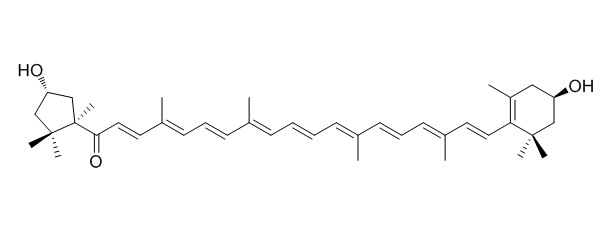Capsanthin
Capsanthin has antioxidant activity.
Inquire / Order:
manager@chemfaces.com
Technical Inquiries:
service@chemfaces.com
Tel:
+86-27-84237783
Fax:
+86-27-84254680
Address:
1 Building, No. 83, CheCheng Rd., Wuhan Economic and Technological Development Zone, Wuhan, Hubei 430056, PRC
Providing storage is as stated on the product vial and the vial is kept tightly sealed, the product can be stored for up to
24 months(2-8C).
Wherever possible, you should prepare and use solutions on the same day. However, if you need to make up stock solutions in advance, we recommend that you store the solution as aliquots in tightly sealed vials at -20C. Generally, these will be useable for up to two weeks. Before use, and prior to opening the vial we recommend that you allow your product to equilibrate to room temperature for at least 1 hour.
Need more advice on solubility, usage and handling? Please email to: service@chemfaces.com
The packaging of the product may have turned upside down during transportation, resulting in the natural compounds adhering to the neck or cap of the vial. take the vial out of its packaging and gently shake to let the compounds fall to the bottom of the vial. for liquid products, centrifuge at 200-500 RPM to gather the liquid at the bottom of the vial. try to avoid loss or contamination during handling.
Phytomedicine.2024, 122:155065.
J Nat Prod.2019, 82(4):1002-1008
SRM Institute of Sci&Tech2022, 34(1): 32-37
Virulence.2018, 9(1):588-603
Curr Res Food Sci.2024, 9:100827.
Horticulturae2021, 7(1),5.
Food Research2022, 6(6): 30-38.
Pol J Microbiol.2021, 70(1):117-130.
Mol Plant Pathol.2022, 10.1111:mpp.13280.
J Int Med Res.2021, 49(7):3000605211032849.
Related and Featured Products
Journal of Agricultural and Food Chemistry,1998,46(9):3468-3472.
Antioxidant Activity of Capsanthin and the Fatty Acid Esters in Paprika (Capsicumannuum).[Reference:
WebLink]
The antioxidant ability of Capsanthin and the fatty acid esters was examined by measuring the free radical-oxidation of methyl linoleate.
METHODS AND RESULTS:
To assess radical scavenging effect, the production of methyl linoleate hydroperoxides and the decomposition of Capsanthins in reaction solution were measured by HPLC. Capsanthin suppressed hydroperoxide formation as well as β-carotene, lutein, and zeaxanthin. Interestingly, Capsanthin decomposed more slowly than the other carotenoids, and the radical scavenging effect of Capsanthin was found to last longer. Also, the Capsanthin esterified partially and/or totally with fatty acids (mono- and/or diesterified Capsanthin), isolated from paprika color, suppressed oxidation of methyl linoleate in a similar manner as nonesterified Capsanthin.
CONCLUSIONS:
This finding suggests that the radical scavenging ability of Capsanthin was not influenced by esterification, that is, the ability would contribute to the polyene chain, especially conjugated keto group. It was first found that esterified (monoesterified and diesterified) Capsanthins also were good radical scavengers.



